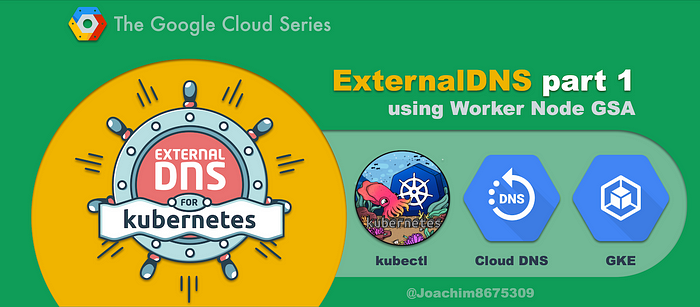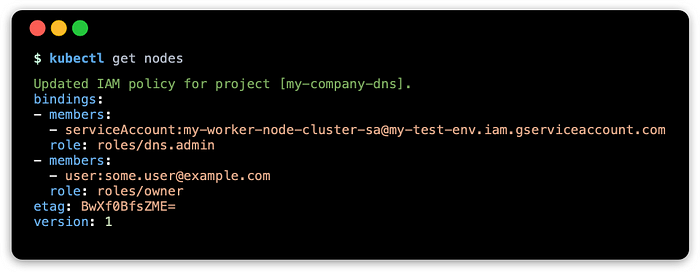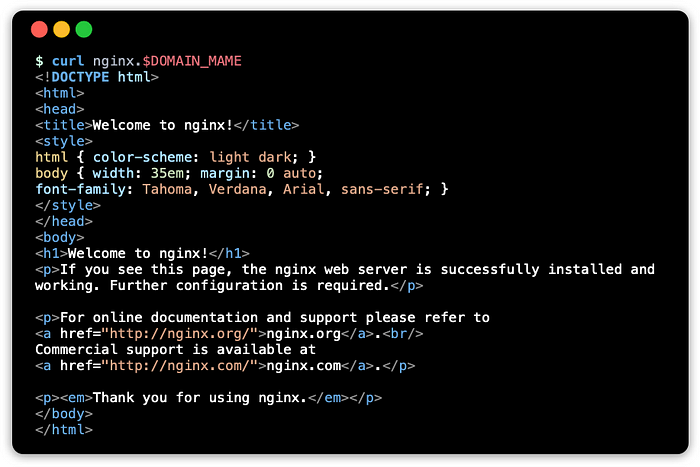
ExternalDNS with GKE & Cloud DNS
ExternalDNS with worker node GSA to access to Cloud DNS
ExternalDNS automates updating DNS records as part of the deployment of a public facing web application. Thus, you do not need to use different tools to update corresponding DNS records to support the application, just only Kubernetes is needed.
This tutorial demonstrates how to setup and configure this on Google Kubernetes Engine (GKE) and Cloud DNS zones.
📔 NOTE: This was tested on following below and may not work if versions are significantly different.* Kubernetes API v1.21
* kubectl v1.24
* gcloud 385.0.0
* ExternalDNS v0.11.0
Knowledge Requirements
This tutorial requires basic understanding of the DNS protocol, cloud platforms like GCP, and the container orchestration platform of Kubernetes.
Specifically, you will need to know how to setup Google cloud projects and resources using Google Cloud SDK (gcloud command), and configuring Kubernetes with KUBECONFIG environment variable, and using the kubectl tool to deploy resources.
Tool requirements
The following tools are needed:
- Google Cloud SDK 385.0.0 or greater
- Kubernetes client (
kubectl) v1.24 or higher
All client scripts were tested using using bash v5.1, (other POSIX shells should work) with Kubernetes v1.21.11-gke.900.
Setup
Use these environment variables and adjust as needed:
The DOMAIN_NAME will need to change to a domain that is under your control. The domain example.com will be used as an example domain for this tutorial.
Creating Google projects
There will be two projects: one to manage the DNS zones and another to run applications. It is a very common practice to segregate resources in this way, as it is easier to manage and keep secure.
You will need to know your billing account number, and use this to link the project to the billing account, so that you can create resources. You will also need to enable required API services related to the resources you wish to create.
You can do all this with the steps below:
Cloud DNS zone
If you do not yet have a Cloud DNS zone available, you can create one through these steps:
This should output a list similar to this:
ns-cloud-d1.googledomains.com.
ns-cloud-d2.googledomains.com.
ns-cloud-d3.googledomains.com.
ns-cloud-d4.googledomains.com.Update domain registrar name servers
In this tutorial example.com is used as an example domain. If you own a domain that was registered with a third-party domain registrar, you should point your domain’s name servers to the values printed from the above list.
Create a cluster
A Kubernetes cluster will deploy containers across a pool of several worker nodes. This node pool is implemented as managed instance groups that manages several GCE (Google compute engine) instances as a single set, scaling them up and down.
These instances will have a common identity, a GSA (Google service account), which needs to be created first (as per best practices). Afterward, the GKE is brought up using that worker node GSA.
Worker node GSA
Run the following below to create the worker node GSA, which will have the minimum necessary privileges.
⚠️ ️NOTE ⚠️This step is vital as the default GCE service account has extra unnecessary privilege of role editor, allowing a potentially malicious actor to grant itself more privileges.
Google Kubernetes Engine
Run the following below with the option to designate the worker node GSA:
When the cluster comes up, you can test it with:
kubectl get nodesThis should show something like:

Create namespaces
In Kubernetes, a common practice is to install applications into separate namespaces.
Personally, I like to put cluster-wide solutions like ExternalDNS into kube-addons, and applications into their own unique namespace.
Here’s how you can create all the namespaces that are used in this project:
Granting access using the worker node GSA method
Before we created an identity ($GKE_SA_EMAIL) has the minimal privileges needed to operate as a Kubernetes node.
Now we want to allow worker node GSA to have cross project access to the Cloud DNS zone.
⚠️🚨 WARNING 🚨⚠️This configuration grants ALL containers running on the cluster access to the Cloud DNS zone, not just the ExternalDNS container. As such, this is suitable for disposable test environments. This is NOT recommended for production systems.
The output of the above command should show something like this:

This will show the updated binding associations from the DNS project. There will be one new entry that shows the binding between dns.admin role in this project to the worker node GSA from the GKE project.
Deploy ExternalDNS
Save the following below as externaldns.yaml.
This manifest will have the necessary components to deploy ExternalDNS on a single pod.
Before deploying, edit the file and replace $DOMAIN_NAME with the domain name, such as example.com, and also replace ${EXTERNALDNS_NS:-"default"} with the desired namespace, such as kube-addons.
When ready, you can deploy this with:
kubectl create --filename externaldns.yaml \
--namespace ${EXTERNALDNS_NS:-"default"}You can look at the objects deployed with:
kubectl get all --namespace ${EXTERNALDNS_NS:-"default"}View logs
You can see right a way if ExternalDNS is successful or has trouble from the logs:
POD_NAME=$(kubectl get pods \
--selector "app.kubernetes.io/name=external-dns" \
--namespace ${EXTERNALDNS_NS:-"default"} --output name)kubectl logs $POD_NAME --namespace ${EXTERNALDNS_NS:-"default"}
Troubles:
time="2022-05-25T08:21:53Z" level=error msg="googleapi: Error 403: Forbidden, forbidden"Success:
time="2022-05-25T07:21:17Z" level=info msg="All records are already up to date"Verify with a service object
For quick demonstration that things are working, we can deploy a small nginx web server. For a service object, you use an annotation to confiugre the FQDN (fully qualified domain name) of the web service like nginx.example.com.
Save the manifest below as nginx.yaml:
Change $DOMAIN_NAME to a domain, such as example.com. When ready to deploy the ingress, run:
kubectl create --filename nginx.yaml \
--namespace ${NGINXDEMO_NS:-"default"}Check to see if the service has an external address (this may take some seconds):
kubectl get service --namespace ${NGINXDEMO_NS:-"default"}You may see something similar to this:

Service: verify record changes on Cloud DNS zone
Verify records have been updated:
gcloud --project $DNS_PROJECT_ID dns record-sets list \
--zone "${DOMAIN_NAME/./-}" --name "nginx.$DOMAIN_NAME."This should show something like:

Service: query using dig
You can use dig to run a query against both the Cloud DNS name server and the default name server:
NAME_SERVER=$(head -1 <<< $NS_LIST)dig +short @$NAME_SERVER nginx.$DOMAIN_NAME
dig +short nginx.$DOMAIN_NAME
These both should show the public IP address that is registered in the Cloud DNS zone.
Service: test with curl
Use curl to get a response using the FQDN:
curl nginx.$DOMAIN_NAMEThis should show something like:

Verify with an ingress object
ExternalDNS supports ingress objects, where it will scan for new ingress objects and update the CloudDNS zone with record based on the host name in the ingress. The ingress controller will route incoming traffic to the appropriate backend service after it matches the value that was set in the host name.
⚠️ NOTE: This tutorial uses two endpoints, a service with an external load balancer and an ingress. This is only for demonstration purposes to illustrate configuring these resources for ExternalDNS. For practical purposes, only one endpoint is needed, so when the ingress is used, the service type can be changed to NodePort.
Default ingress controller: ingress-gce
GKE comes bundled with a default ingress controller called ingress-gce or GLBC, which is a GCE layer 7 (HTTP/S) load balancer.
As this load balancer sits outside of the Kubernetes cluster, it requires an IP address that is accessible from the external network, so services with the NodePort or LoadBalancer types will work fine.
A service with a type of ClusterIP is not directly accessible from outside of the cluster, so this is not supported.
This is different from popular ingress controllers like ambassador or ingress-nginx, which live inside of the cluster, so they can route traffic to IP addresses that are only accessible inside of the Kubernetes cluster.
Ingress manifests
Save the following below as ingress.yaml.
Change $DOMAIN_NAME to a domain, such as example.com. When ready to deploy the ingress, run:
kubectl create --filename ingress.yaml \
--namespace ${NGINXDEMO_NS:-"default"}Check to see if the ingress has an external address (this may take some seconds):
kubectl get ingress --namespace ${NGINXDEMO_NS:-"default"}You may see something similar to this:

Ingress: Verify record changes on Cloud DNS zone
Verify records have been updated to reflect the ingress object’s address:
gcloud --project $DNS_PROJECT_ID dns record-sets list \
--zone "${DOMAIN_NAME/./-}" --name "server.$DOMAIN_NAME."This should show something like:

Ingress: Query using dig
You can use dig to run a query against both the Cloud DNS name server and the default name server:
NAME_SERVER=$(head -1 <<< $NS_LIST)dig +short @$NAME_SERVER server.$DOMAIN_NAME
dig +short server.$DOMAIN_NAME
Ingress: test with curl
Use curl to get a response using the FQDN:
curl server.$DOMAIN_NAMEThis should show something like:

Cleaning up
You can delete the cluster and allocated load balancers with:
gcloud container clusters delete $GKE_CLUSTER_NAME \
--project $GKE_PROJECT_ID --region $GKE_REGIONAs the privileges are no longer needed, it is a good practice to remove privileges for the worker node GSA.
gcloud projects remove-iam-policy-binding $DNS_PROJECT_ID \
--member serviceAccount:$GKE_SA_EMAIL \
--role roles/dns.adminIf the worker node GSA is no longer needed, you can delete it with:
gcloud iam service-accounts delete $GKE_SA_EMAIL \
--project $GKE_PROJECT_IDResources
These are some documentation links and resources I have come across while doing this blog
Google Documentation
- Authentication overview
- Best practices for using and managing service accounts
- Harden your cluster’s security
- Security Overview
ExternalDNS
This tutorial is based on docs I updated to the ExternalDNS project (pull request review phase)
- ExternalDNS GKE tutorial (latest)
Conclusion
The goal of all of this adventure is to demonstrate ExternalDNS on GKE with Cloud DNS, and walk through using gcloud and kubectl tools to set all of this up.
This tutorial walks through some of the security aspects of segregating cloud resources into different projects, and then setting up permissions for the ExternalDNS to access resources in another project.
Accessing resources across projects is a common practice I found in the industry, and I see a lot of people online confused by this, so I hope this helps in understanding identities and policy binding (role to service account relationships).
This method with worker node GSA, which will grant access to all containers on the Kubernetes cluster is only suitable if all containers need the same level of access. An example of such scenario would be using a private container registry, where all containers may need read-only access to GCR.
For write-access, this should be limited to just the services that need it, either through a credentials.json file, or for a far better solution, Workload Identity, which allows a KSA (Kubernetes service account) to assume identity of the GSA (Google service account). More on this topic in the future…
